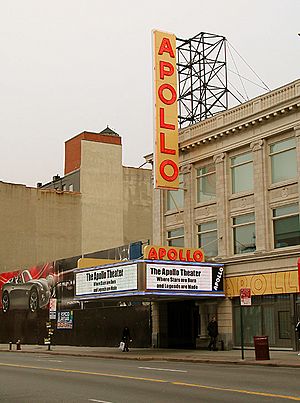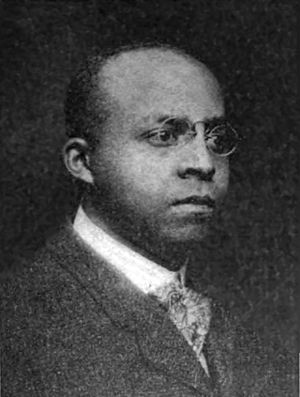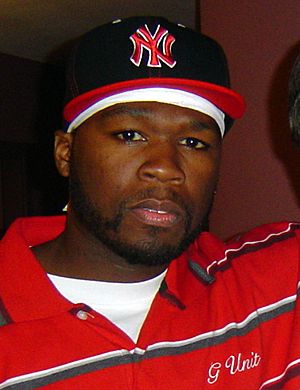African Americans in New York City facts for kids
| Total population | |
|---|---|
| 2.1 million alone (25%), 2.2 million including partial African ancestry (27%) (2019) | |
| Regions with significant populations | |
| Central Harlem, the north Bronx, central Brooklyn, and southeast Queens | |
| Languages | |
| African American Vernacular English, New York City English, American English, Caribbean English, Jamaican Patois | |
| Religion | |
| Christianity, Judaism, Islam, irreligious | |
| Related ethnic groups | |
| Caribbeans in New York City, Black Jews in New York City, Puerto Ricans in New York City |
African Americans have been an important part of New York City's history for a very long time. Most African Americans living in the United States today are descendants of people who were brought to the American South from West and Central Africa against their will through the Atlantic slave trade.
Contents
African Americans in New York City
Population Today

New York City has the largest number of Black residents of any city in the U.S. In 2010, over 2 million Black people lived within the city. This number has changed a bit since then. For a long time, New York City had more Black people than the entire state of California.
The Black community in New York City is very diverse. It includes people whose families have been in America for generations, as well as immigrants and their children from Africa and the Caribbean. Many Black New Yorkers live in areas like Brooklyn, Queens, Harlem, and The Bronx. Some neighborhoods, like Bedford–Stuyvesant in Brooklyn and Harlem in Manhattan, are known as important places where urban Black culture grew in America. Bedford-Stuyvesant is thought to have one of the highest numbers of Black residents in the United States.
New York City is also home to the largest number of Black immigrants. These include people from the Caribbean (like Jamaica, Trinidad and Tobago, and Haiti), Afro-Latinos from Latin America, and people from countries in sub-Saharan Africa.
A Look Back at History
Slavery in New York
The history of African Americans in New York City began with slavery. People were forced to come to New York and work without pay. Slavery was finally ended in New York in 1827.
After Slavery Ended
After slavery was abolished, New York City became a major center for free African Americans before the American Civil War. Many groups and organizations were started to help the community. For example, Freedom's Journal was the first newspaper for African Americans. It spoke out against slavery and shared important information. The African Dorcas Association helped Black children get an education and clothes.
However, even after slavery ended, Black men in New York did not have equal voting rights. For many years, they had to own a certain amount of property to vote, which was a rule that didn't apply to white men. Black men finally gained equal voting rights in New York in 1870, when the Fifteenth Amendment was passed.
Free African Americans created their own communities in the New York City area. These included Seneca Village (which is now part of Central Park), Sandy Ground on Staten Island, and Weeksville in Brooklyn. New York City was also a very important place for the abolitionist movement, which worked to end slavery across the country.
The Great Migration and Harlem
After the Civil War, harsh Jim Crow laws in the Southern states led to a huge movement of African Americans to northern cities, including New York City. This movement is known as the Great Migration. Many Black people, including former slaves and their children, moved to New York looking for better opportunities and to escape unfair treatment.
Around this time, Harlem became the main center for African American life and culture in New York City. A real estate businessman named Philip A. Payton, Jr. played a big role. In 1904, he started a company that bought and leased homes in Harlem, which was then mostly white. This led to many African Americans moving to Harlem from other parts of the city, like Greenwich Village and Hell's Kitchen. They also moved because they feared anti-Black riots that had happened in other neighborhoods.
The Great Depression and Shifting Communities
Harlem's importance as the main center for African Americans in New York City began to change when the Great Depression started in 1929. Many people in Harlem lost their jobs, and it was hard to find new work for a long time. Some jobs that Black New Yorkers traditionally held were taken by other groups.
During this time, many African Americans moved from an overcrowded Harlem to Bedford–Stuyvesant in Brooklyn, where there was more housing. By 1950, the number of Black people in Bedford-Stuyvesant had grown to 155,000, making up about 55% of the neighborhood's population.
African Americans and the COVID-19 Pandemic
The COVID-19 pandemic affected African Americans in the United States more than other groups. Black Americans were more likely to get sick, be hospitalized, and die from COVID-19. This was due to several reasons:
- Many Black Americans worked essential jobs, like grocery store workers or transit workers, which put them at higher risk of exposure.
- They often had jobs without health insurance, making it harder to get proper medical care.
- The Black church, which is a key place for community support, faced challenges due to social distancing rules. This made it harder for people to get the help they needed.
In New York City, the pandemic showed how unfair the healthcare system could be. Neighborhoods with mostly Black residents often had less access to important healthcare resources. This was very different from wealthier areas that had plenty of hospital beds and supplies. Data showed that zip codes with mostly Black or Hispanic residents had much higher rates of COVID-19 cases and deaths.
Notable New Yorkers
|
Amazing Accomplishments
Many African Americans from New York City have achieved great things and broken barriers:
- Adam Clayton Powell Jr. - The first African American elected to Congress from New York.
- Alonzo Smythe Yerby - The first Black chairman of a public health department and the first Black New York City Hospitals Commissioner.
- Arthur Mitchell - The first African American male dancer and principal dancer in a major ballet company (New York City Ballet).
- Brigette A. Bryant - The first African American woman to be Vice Chancellor of the City University of New York.
- David Dinkins - The first African American mayor of New York City (1990).
- Dr. James McCune Smith - The first formally trained African American Medical Doctor.
- Letitia James - The first African American woman elected to a citywide office in New York City (New York City Public Advocate).
- Mary Pinkett - The first African American woman elected to the New York City Council.
- Robert O. Lowery - The first African American fire commissioner of the New York City Fire Department.
- Samuel J. Battle - The first African American police officer in the New York Police Department (1911). He was also the first African American sergeant, lieutenant, and parole commissioner in the NYPD.
- Shirley Chisholm - The first Black woman elected to the U.S. Congress and the first Black person to run for president for a major party.
- Todd Duncan - The first African American member of the New York City Opera.
- Wesley Augustus Williams - The first African American officer in the New York Fire Department.
- William Grant Still's Troubled Island - The first opera by a Black composer to be performed by a major U.S. company (New York City Opera).
- Willie Overton - The first African American police officer in what is now New York City (1891).
See Also
- Demographics of New York City
- History of slavery in New York (state)
- Afro-Caribbean people
- Caribbean immigration to New York City
- Medgar Evers College
- Schomburg Center for Research in Black Culture
- Black Jews in New York City
- East Coast hip hop
- Universal Hip Hop Parade
- Puerto Ricans in New York City
- Black Lives Matter protests in New York City
- Black Lives Matter art in New York City
- African American Day Parade
- Little Africa, Manhattan
- Land of the Blacks (Manhattan)




